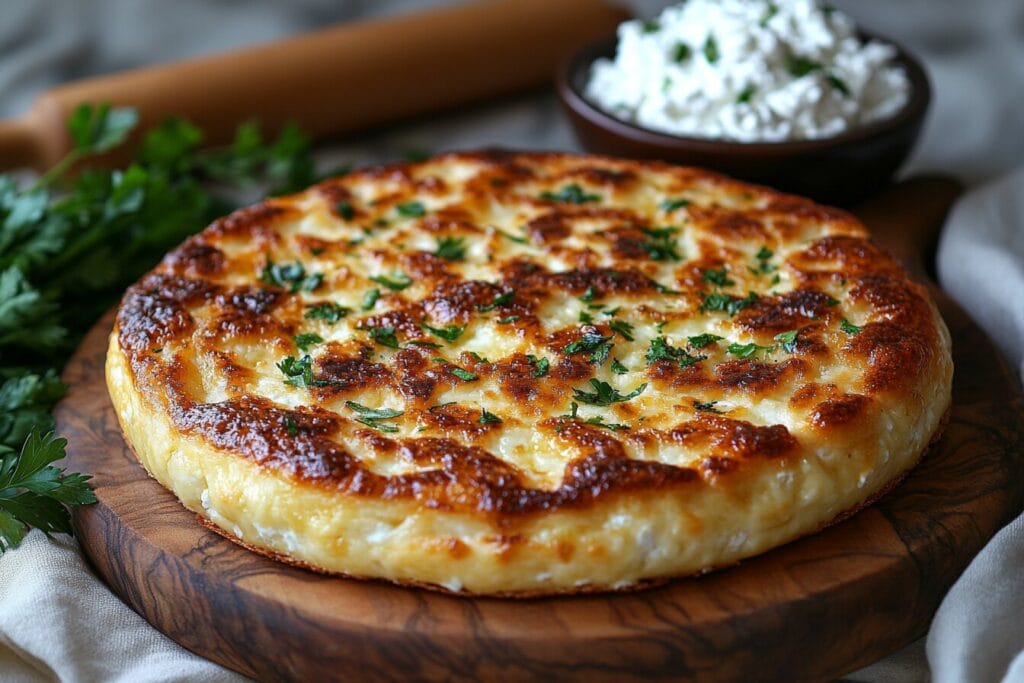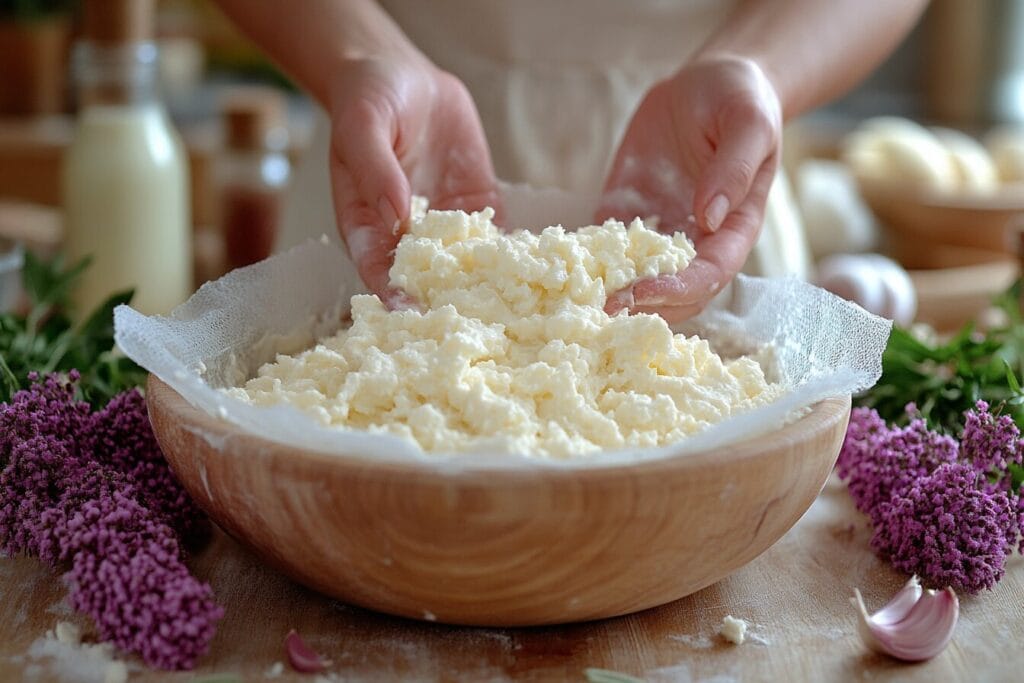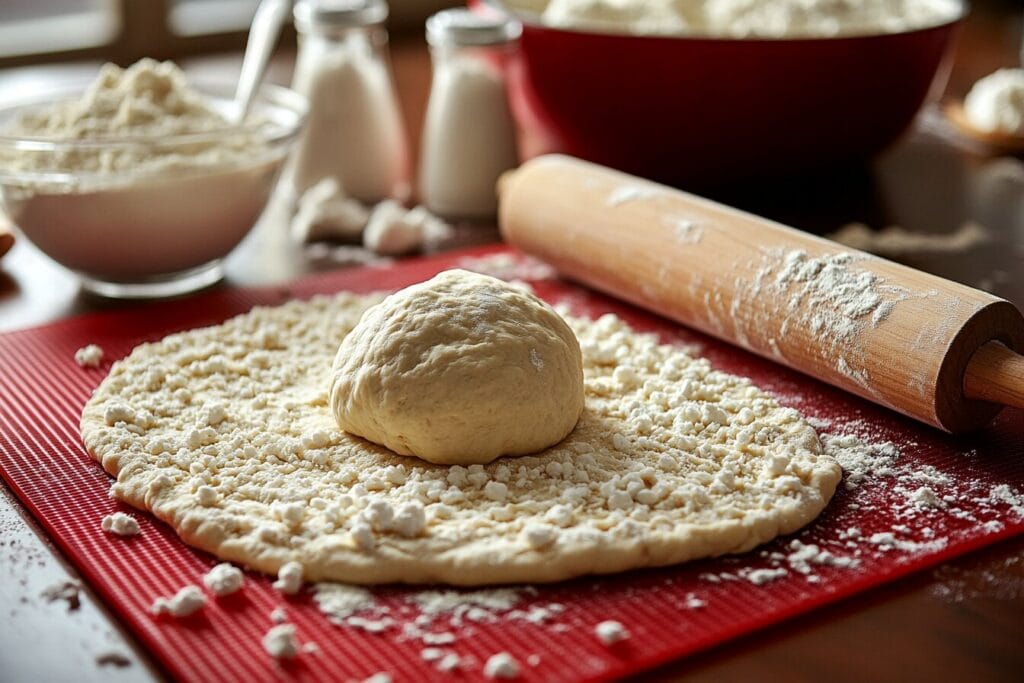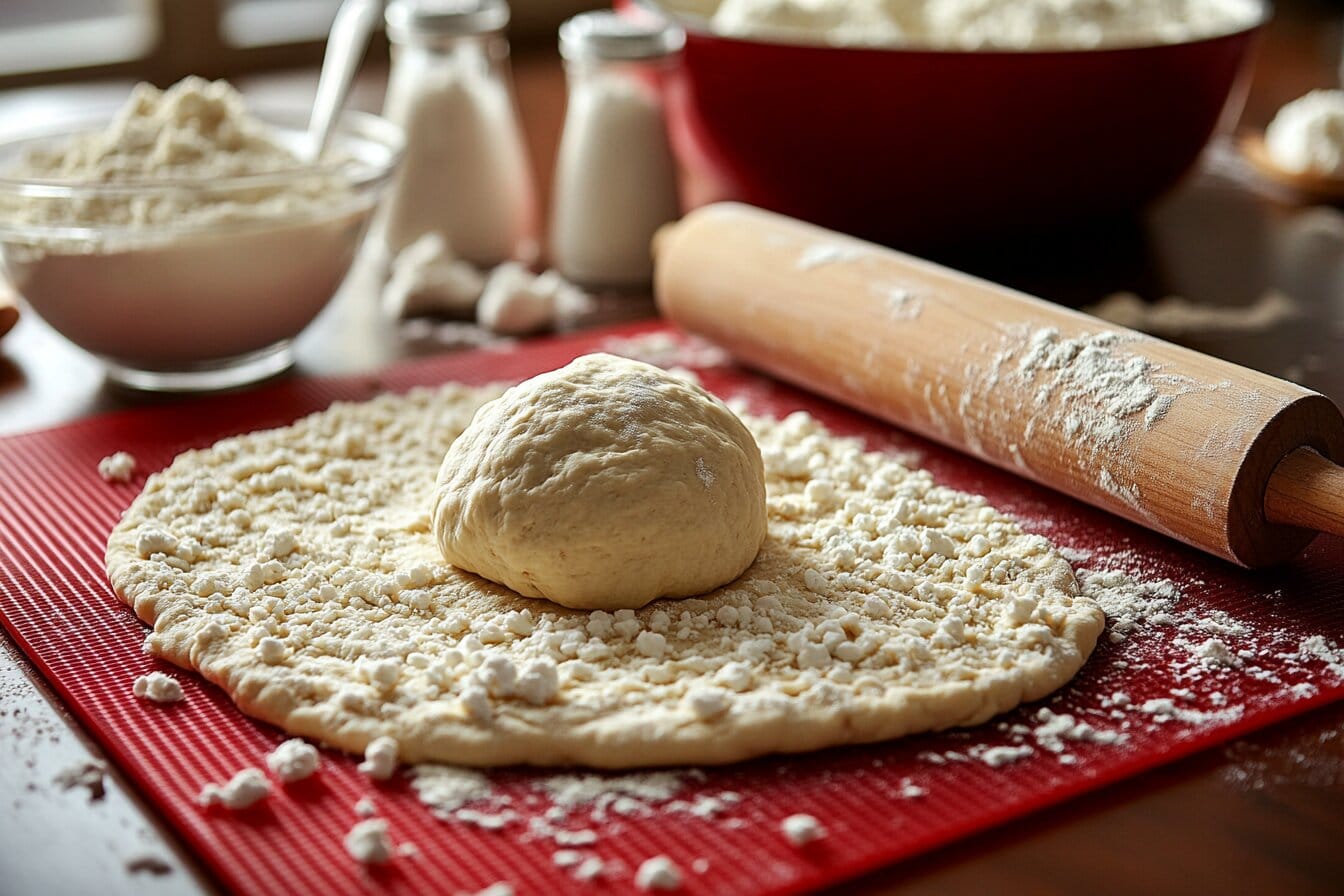Table of Contents
Cottage cheese flatbread is a wholesome and nutritious option cherished for its soft texture, subtle flavor, and versatility in meals. However, one common challenge many face is figuring out how to keep cottage cheese flatbread from sticking during preparation or cooking. Whether you enjoy it topped with fresh herbs or as a base for savory spreads, mastering this technique ensures a mess-free and enjoyable cooking experience.
However, one frustrating challenge is preventing the flatbread from sticking to your rolling surface, cooking pan, or spatula. Sticking not only makes cooking messier but can also ruin the shape and texture of your flatbread. This guide will help you navigate these challenges by offering actionable tips and proven methods to keep your cottage cheese flatbread from sticking, ensuring an enjoyable cooking experience every time.

Understanding the Basics
What Causes Flatbread to Stick?
Sticking often occurs due to a combination of factors, including:
- Dough Consistency: Overly wet or sticky dough can adhere to surfaces.
- Insufficient Flour or Oil: Lack of a non-stick barrier increases the risk of sticking.
- Improper Equipment: Certain pans or griddles are more prone to food sticking.
- Incorrect Heat Levels: Cooking at very low or excessively high temperatures can make sticking worse.
Why Cottage Cheese Flatbread Is Prone to Sticking
Cottage cheese contains a high moisture content, which can make the dough softer and more prone to sticking than other flatbreads. Understanding how to manage this moisture effectively is key to success.
Preparation Tips
1. Choose the Right Cottage Cheese
Opt for cottage cheese with a moderate moisture level. If the cottage cheese is too watery, strain it through a cheesecloth or fine mesh sieve to reduce the liquid. This step ensures the dough remains workable without becoming overly sticky.
2. Balance Dough Ingredients
While preparing the dough, gradually add flour to achieve the right consistency. The dough should be soft and slightly tacky but not cling to your fingers. Using whole wheat or all-purpose flour can provide a sturdy base for the flatbread.
3. Flour the Surface and Hands
Dust your work surface, rolling pin, and hands with flour before rolling out the dough. A light but even coating of flour prevents the dough from adhering while maintaining its elasticity.
4. Add Oil to the Dough
Incorporating a small amount of oil into the dough during kneading can reduce its stickiness. Olive oil or neutral cooking oils work well without altering the flavor profile of the flatbread.

Cooking Surface and Equipment
1. Use Non-Stick Pans or Griddles
Non-stick pans and griddles are ideal for cooking cottage cheese flatbread. They offer a smooth surface that minimizes the risk of food sticking during cooking.
2. Preheat Properly
Ensure your cooking surface is preheated before placing the flatbread. Cooking on a cold surface increases the likelihood of sticking. A medium heat setting is typically ideal.
3. Season Cast Iron Pans
If you prefer using cast iron, ensure the pan is well-seasoned. A properly seasoned cast iron pan creates a natural non-stick coating that works beautifully for flatbreads.
4. Invest in a Silicone Mat or Parchment Paper
For rolling and shaping the dough, a silicone baking mat or parchment paper provides an excellent non-stick alternative to traditional floured surfaces.
Cooking Techniques to Prevent Sticking
1. Grease the Pan Lightly
Use a small amount of oil or butter to coat the pan before cooking. Avoid overloading with oil, as this can create an uneven texture or greasy flatbread.
2. Avoid Overcrowding
Cook one or two flatbreads at a time, depending on the size of your pan. Overcrowding can lead to uneven cooking and sticking.
3. Flip Carefully
When it’s time to flip the flatbread, use a wide spatula to lift the edges gently before turning it over. This technique minimizes tearing and sticking.
4. Monitor Heat Levels
Maintain a steady medium heat to cook the flatbread evenly without sticking. High heat may scorch the flatbread, causing it to stick, while low heat may make it soggy.
Troubleshooting Common Issues
Despite your best efforts, you might still encounter occasional problems with cottage cheese flatbread sticking during preparation or cooking. Here’s how to address common issues effectively:
1. The Dough Is Too Sticky
- Symptoms: The dough sticks excessively to your hands, rolling pin, or work surface, making it difficult to handle.
- Solution:
- Add small amounts of flour, one tablespoon at a time, until the dough is workable.
- Chill the dough for 15–20 minutes before rolling; this helps reduce stickiness by firming the texture.
- Use a silicone baking mat instead of a wooden or metal surface for rolling.
2. Flatbread Sticks to the Pan
- Symptoms: The flatbread tears or leaves residue on the cooking surface.
- Solution:
- Preheat the pan thoroughly before cooking to ensure an even surface temperature.
- Apply a thin layer of oil or butter using a brush or paper towel. Avoid pouring oil directly into the pan.
- Use a non-stick or well-seasoned cast iron pan. If residue builds up, clean the surface and re-season as needed.
3. Uneven Cooking or Burnt Edges
- Symptoms: Some parts of the flatbread are undercooked while others are burnt.
- Solution:
- Cook on medium heat to give the flatbread ample time to cook through without burning.
- Rotate the pan occasionally to distribute heat evenly.
- Use a spatula to press down lightly on thick edges, ensuring even contact with the pan.
4. Dough Tearing During Rolling or Cooking
- Symptoms: The dough rips when rolled out or flipped in the pan.
- Solution:
- Rest the dough for 10–15 minutes before rolling. This relaxes the gluten and makes it more pliable.
- Roll gently and evenly, starting from the center and working outward.
- Dust the rolling pin and surface with a small amount of flour to prevent sticking.
5. Residue Build-Up on Cooking Surface
- Symptoms: Bits of dough or burnt flour accumulate on the pan, increasing sticking over time.
- Solution:
- Wipe the pan clean between batches with a damp cloth or paper towel.
- Avoid using excessive flour during rolling, as it can burn and stick to the pan.
Enhancing Your Flatbread Cooking Routine
Experiment with Cooking Oils
Different oils can impact the non-stick properties of your pan and the flavor of your flatbread. For instance:
- Olive Oil: Provides a rich flavor and works well at moderate temperatures.
- Coconut Oil: Offers a slight sweetness and good non-stick qualities.
- Ghee or Butter: Adds a golden, crisp finish and prevents sticking effectively.
Use Proper Cooking Tools
Invest in a wide, thin-edged spatula for easy flipping, and avoid using metal utensils on non-stick pans to prevent damage.
Work in Batches
Cooking flatbread in smaller batches ensures better control over heat and prevents overcrowding, which can lead to sticking and uneven cooking.
Cooking Techniques to Achieve Perfect Non-Sticking Flatbread
Proper cooking techniques can make a significant difference in preventing cottage cheese flatbread from sticking. By focusing on key methods, you’ll achieve evenly cooked, non-sticky flatbreads with minimal effort.
1. Preparing the Pan
Before placing the flatbread on the pan, ensure that the cooking surface is well-prepped:
- Preheat Gradually: Allow the pan to heat over medium heat for 2–3 minutes. A well-heated surface ensures that the dough cooks immediately upon contact, reducing the chances of sticking.
- Light Oil Coating: Use a small amount of oil or melted butter. Spread it evenly using a paper towel or brush for a thin layer. Excess oil can cause uneven cooking and greasiness.
2. Flipping with Precision
Flipping flatbread requires careful timing and technique to maintain its structure and avoid sticking:
- Check Doneness Before Flipping: Wait until the first side is lightly golden and releases easily from the pan before flipping. If the flatbread sticks, give it another 20–30 seconds to cook further.
- Use the Right Tool: A wide, non-stick spatula or fish turner works best for flipping. Slide the spatula underneath gently, lifting the edges before flipping entirely.
3. Controlling Temperature
Maintaining the correct temperature is critical for non-sticking success:
- Medium Heat is Ideal: Too high, and the flatbread may burn and stick; too low, and it may become soggy. Medium heat ensures thorough cooking with a crisp exterior.
- Adjust as Needed: If the flatbread cooks too quickly or slowly, adjust the heat incrementally. Keep an eye on the cooking surface to prevent overheating.
4. Layering Flatbreads Post-Cooking
Once the flatbreads are cooked, layer them with parchment paper or a clean kitchen towel between each to prevent sticking together as they cool.
Best Practices for Rolling and Shaping Dough

1. Roll on Non-Stick Surfaces
Using a non-stick rolling surface such as a silicone mat reduces the need for excess flour, which can alter the texture of your flatbread.
2. Work with Smaller Dough Portions
Divide the dough into smaller, manageable portions. Rolling smaller pieces makes it easier to control the thickness and prevents tearing.
3. Use a Light Hand
Apply gentle, even pressure when rolling the dough. Avoid pressing too hard, as this can cause the dough to stick to the rolling pin or surface.
4. Experiment with Thickness
The thickness of your flatbread affects its cooking and sticking properties:
- Thinner Flatbread: Cooks quickly but requires careful flipping to prevent tearing.
- Thicker Flatbread: More forgiving to handle but requires slightly longer cooking time.
Additional Tips for Perfect Flatbread
Incorporate Spices or Herbs
Mixing spices like cumin, paprika, or chopped fresh herbs into the dough not only enhances flavor but also slightly alters its texture, reducing stickiness.
Dust the Flatbread Lightly Before Cooking
After rolling, dust the surface of the flatbread with flour or semolina. This creates a protective barrier between the dough and the pan.
Cooling the Dough
Resting the dough in the refrigerator for 20–30 minutes before rolling allows the ingredients to bind better, resulting in a less sticky dough.
Frequently Asked Questions (FAQ)
1. Why Does My Cottage Cheese Flatbread Keep Sticking Despite Using Flour?
Even with flour, sticking can occur due to several reasons:
- Excess Moisture in Dough: Cottage cheese has a high moisture content, which can lead to sticky dough. Straining the cheese and balancing the flour ratio can help.
- Insufficient Preheating: If the pan isn’t properly heated, the flatbread may stick instead of cooking immediately upon contact.
- Flour Burn Residue: Excess flour on the cooking surface can burn and create sticky patches. Use just enough flour to dust the dough and surfaces lightly.
2. What’s the Best Type of Pan for Cottage Cheese Flatbread?
The ideal pan depends on your preferences and cooking style:
- Non-Stick Pan: Easiest to use for beginners, requiring minimal oil.
- Cast Iron Skillet: Excellent for even heat distribution and a crispy texture, provided it’s well-seasoned.
- Griddle: Perfect for cooking multiple flatbreads at once, offering a spacious and flat surface.
3. Can I Prevent Sticking Without Using Oil?
Yes, though oil provides a reliable non-stick barrier. Here are alternatives:
- Use a non-stick pan, which requires little to no oil.
- Dust the cooking surface lightly with flour or cornmeal before placing the flatbread.
- Opt for parchment paper if baking instead of frying.
4. How Do I Fix Dough That’s Too Wet to Handle?
If the dough is too sticky:
- Gradually add flour, one tablespoon at a time, kneading until the dough becomes manageable.
- Refrigerate the dough for 20–30 minutes to firm it up.
- Avoid over-mixing, as this can break down the structure of the dough, making it stickier.
5. Can I Use Low-Fat Cottage Cheese for Flatbread?
Yes, but keep in mind that low-fat cottage cheese may have higher water content. Be sure to strain it thoroughly before incorporating it into the dough to prevent excess moisture.
6. What Should I Do If the Flatbread Tears When Flipping?
If your flatbread tears during flipping:
- Ensure the first side is fully cooked and releases easily before flipping.
- Use a wide, flexible spatula for support.
- Work with smaller, thicker flatbreads, which are less prone to tearing.
Conclusion
Preventing cottage cheese flatbread from sticking requires a combination of preparation, proper equipment, and refined cooking techniques. By choosing the right cottage cheese, managing dough moisture, and using non-stick or seasoned cooking surfaces, you can create perfectly cooked flatbreads every time. Remember to experiment with various methods to discover what works best for your kitchen setup and preferences. With practice, your cottage cheese flatbreads will turn out flawlessly—light, fluffy, and effortlessly non-sticky!
Related Links for More Flatbread Tips
📌 Why Is My Cottage Cheese Flatbread Soggy? – Learn how to balance moisture in the dough.
📌 Cottage Cheese Flatbread: A Delicious and Healthy Recipe – Step-by-step guide to making cottage cheese flatbread.
📌 Does Cottage Cheese Flatbread Need to Be Refrigerated? – Find out how to store your flatbread properly.
📌 Best Foods to Pair with Cottage Cheese – Great serving suggestions for your flatbread.

